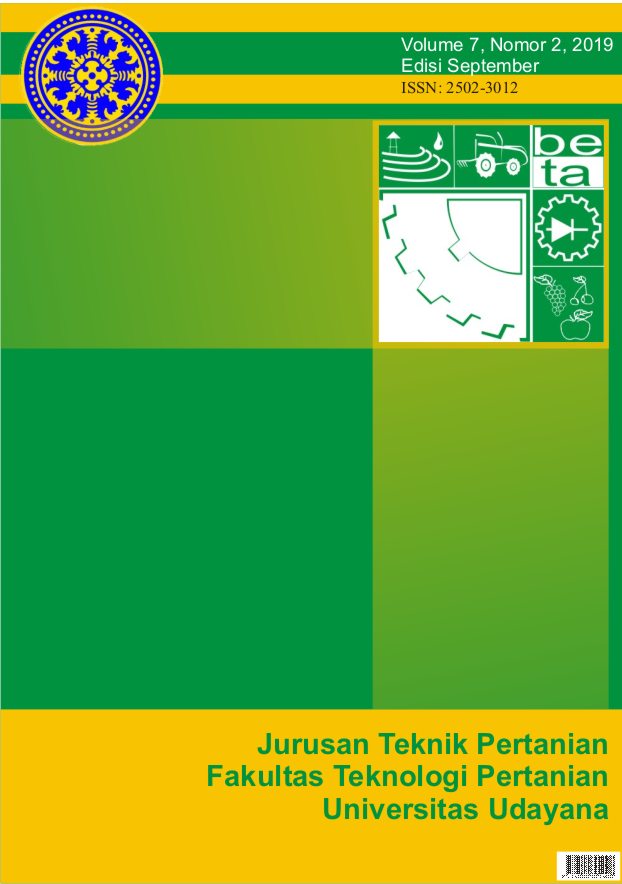Dampak Dosis Kompos Kotoran Sapi Terhadap Profil Suhu Tanah di Zona Perakaran dan Produktivitas Tanaman Pakcoy (Brassica rafa L)
Abstract
Suhu tanah adalah salah satu sifat fisik tanah yang secara langsung mempengaruhi pertumbuhan tanaman pakcoy. Tujuan penelitian ini adalah (1) untuk menganalisis suhu di zona perakaran, (2) menganalisis hubungan antara dosis pemupukan mempergunakan kompos dengan suhu di zona perakaran dan (3) untuk menganalis suhu yang optimum untuk produktivitas dan kualitas pakcoy yang dihasilkan saat panen. Rancangan penelitian yang digunakan rancangan acak lengkap, dengan lima perlakuan dan tiga ulangan. Perlakuan tersebut adalah P0 : dosis kompos 0 kg/m2, P1 : dosis kompos 1 kg/m2, P2 : dosis kompos 2 kg/m2, P3 : dosis kompos 3 kg/m2, dan P4 : dosis kompos 4 kg/m2. Parameter yang diamati pada penelitian ini adalah suhu udara, suhulingkungan, kadar air tanah dan produktivitas. Padamalam hari suhu tanah di zona perakaran lebih tinggi 0,59 oC dari pada suhu lingkungan. Suhu tanah di zona perakaran terendah dan tertinggi adalah 18,02 oC dan 21,94 oC. Suhu tanah malam hari dan siang hari untuk dosis 0-5kg/m2 masih toleran pada tanaman pacoy. Berat kering tanaman pakcoy tertinggi pada perlakuan dosis kompos 4kg/m2 denganberat 92,21 gram/tanaman dan terendah pada perlakuan kontrol dengan berat 71,82 gram/tanaman.
The temperature of the soil is one of the physical properties of the soil, this soil physical properties direc2tly affect plant growth pakcoy. The purpose of this research are (1) to analyze the temperature at root zone, temperature inside and out of the mini greenhouse, (2) analyze the relationship between temperature at root zone with doses of compost fertilizer application and 3) to analyze the optimum dose of compost based on productivity and quality of the pakcoy is generated when the harvest. The design of the research used randomized complete design, with five treatments and three replicates. The treatment is P0: a dose of compost 0 kg/m, P1: a dose of compost 1 kg/m2, P2: a dose of compost 2 kg/m2, P3: the dose of compost 3 kg/m2, and P4: a dose of compost 4 kg/m2. The parameters observed in this research is the air temperature, the temperature of the environment, ground water levels and productivity. At night the temperature of the soil rooting zone higher at 0.59 ºC than at the temperature of the environment. Soil temperature at root zone the lowest and the highest are 18.02 oC and 21.94 oC. The temperature of the soil the night and during the day for dose 0-5 kg/m2 was still tolerant plants pakcoy. Dry weight of the plant the highest pakcoy on the treatment dose of compost 4 kg/m2 with a weight of 92.21 grams/lowest at the treatment plant and the control by the weight of 71.82 grams/plant.
Downloads
References
Darmawijaya, Isa, 1998. Dasar-dasar Klasifikasi Tanah. Gadjah Mada University Press
El-Aswad, R.M. and P.H. Groenevelt, 1985. Hydrophysical Modification and its Effect on Evaporation. Journal of American Society of Agricultural Engineer. No.28 (6) : 1927-1932
Hillel, D, 1998, Pengantar Fisika Tanah, Mitra Gama Widya, Yogyakarta
Inggrit. 2013. Fisiologi Tumbuhan. http:// inggritmemo.com/2013/02/fisiologi-tumbuhan-soal-dan jawaban.html. Diakses 24 Agustus 2018.
Lesmanawati I. R. 2005. Pengaruh pemberian kompos, thiobacillus, dan penanaman gmelina serta sengon pada tailing emas terhadap biodegradasi sianida dan pertumbuhan kedua tanaman [Tesis]. Bogor: Program Pasca Sarjana. Institut Pertanian Bogor.
Samekto R. 2006. Pupuk Kompos. PT Intan Sejati. Klaten.
Setiyo, y., Gunadnya IBP., Gunam IBW., Permana M., Susrusa B., Triani L. 2016. Agriculture and Agricultural Science Procedia. Elsevier.
Setiyo, Y., Ada IW., Susrusa B., Gunam IBW., Gunadnya IBP. dan Yulianti N. 2017. Agribisnis Kentang. Udayana press.
Setyamidjaja, Djoehana. 1986. Pupuk dan Pemupukan. Jakarta : CV. Simplex
Soepardi, G. 1983. Sifat Dan Ciri Tanah. Jurusan Tanah Fakultas Pertanian. IPB. Bogor. 591 hal.
Sudyastuti, Tri dan Nurdin Setyawan. 2007. Sifat Thermal Tanah Pasiran Pantai Dengan Pemberian Bahan Pengkondisi Tanah Dan Biomikro Pada Budidaya Tanaman Cabai (Capsicum Annuum). Universitas Gajah Mada. Yogyakarta.
Widiastuti, L., Tohari, Sulistyaningsih, E. 2004. Pengaruh Intensitas Cahaya dan Kadar Daminosida terhadap Iklim Mikro dan Pertumbuhan Tanaman Krisan dalam Pot. Jurnal Ilmu Pertanian(11) 2:35-42.












 Jurnal BETA (Biosistem dan Teknik Pertanian)
Jurnal BETA (Biosistem dan Teknik Pertanian)


